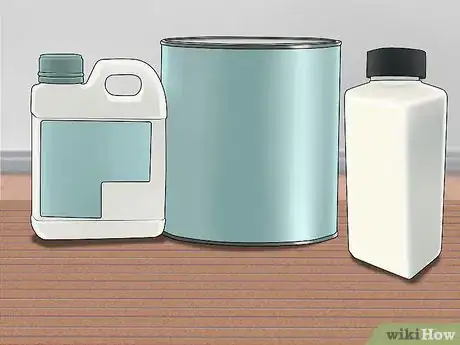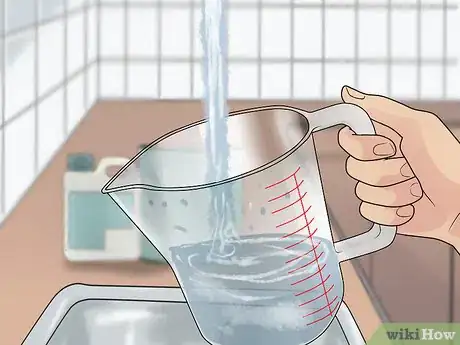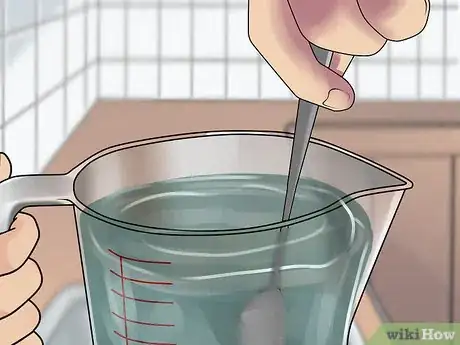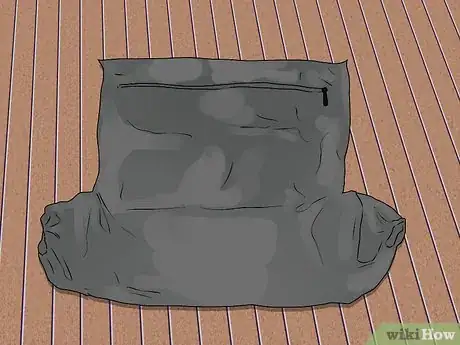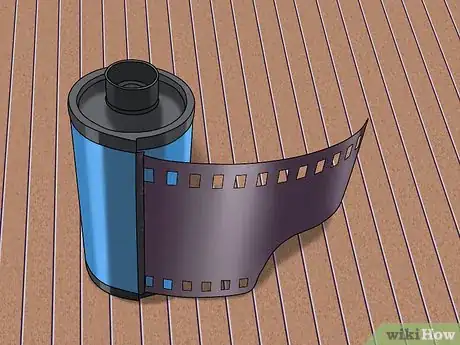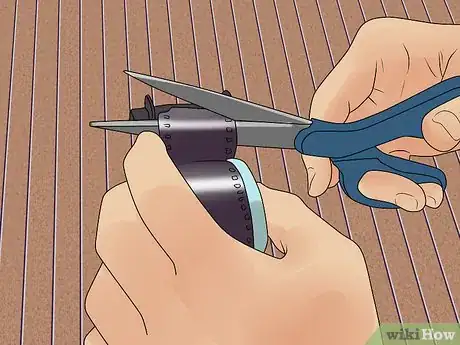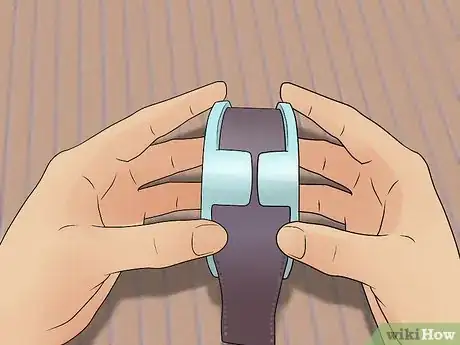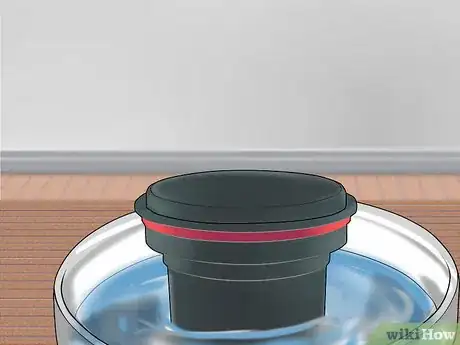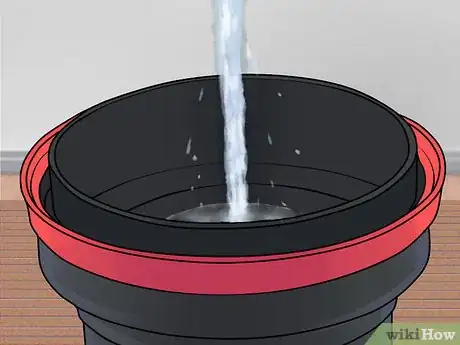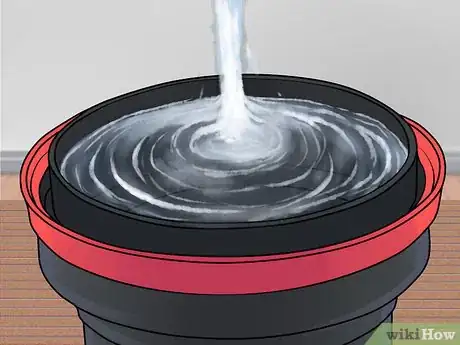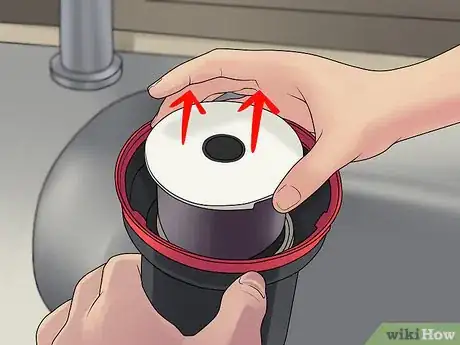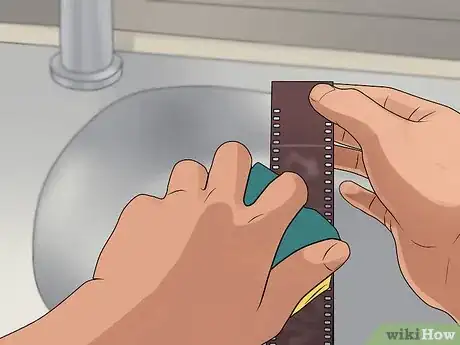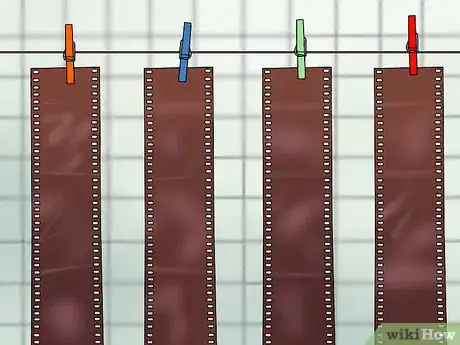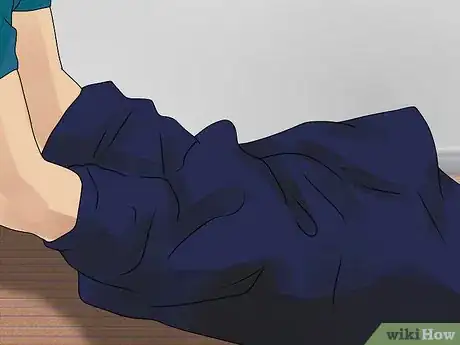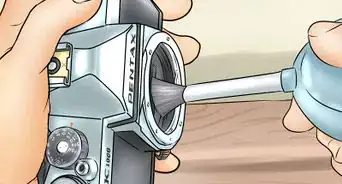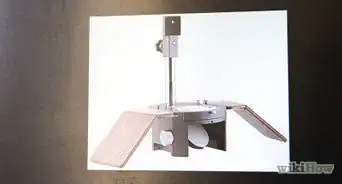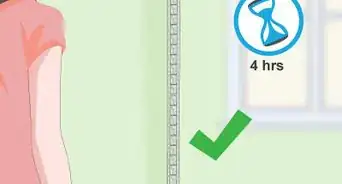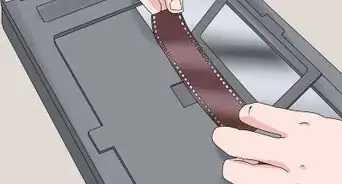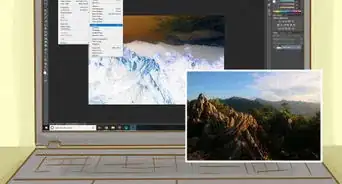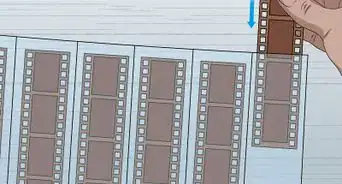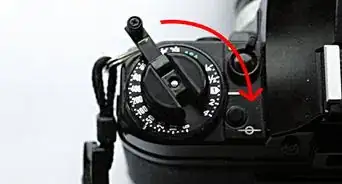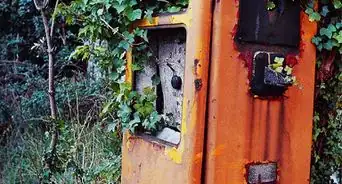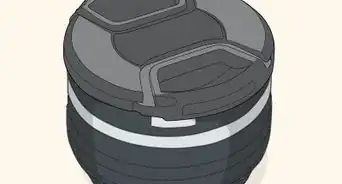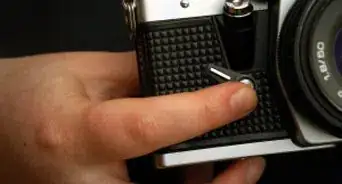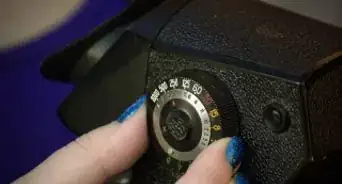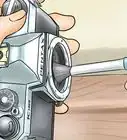This article was co-authored by Or Gozal, a trusted member of wikiHow's volunteer community. Or Gozal has been an amateur photographer since 2007. Her work has been published in, most notably, National Geographic and Stanford University's Leland Quarterly.
wikiHow marks an article as reader-approved once it receives enough positive feedback. In this case, several readers have written to tell us that this article was helpful to them, earning it our reader-approved status.
This article has been viewed 482,351 times.
Learn more...
Preserve a time-honored photography tradition by learning to develop your own color film. To develop film effectively, you need to have your mixed chemicals and a designated space or changing bag to develop the film, as well as a place to dry the negatives once they are developed.
Steps
Mixing Your Chemicals
-
1Buy your chemicals and containers. An online camera shop will sell a C4-1 three chemical powder kit called a "press kit." Then, your containers for mixing the chemicals need to be airtight.[1]
- To ensure the containers are airtight, buy three chemical containers or 3 one-gallon glass jugs. Label them “Developer,” “Blix,” and “Stabilizer.” This is so you do not confuse the chemicals and accidentally mix them together.
-
2Dilute the Developer. Get a plastic measuring pitcher and fill it with clean tap water at 110 degrees Fahrenheit or 43.5 degrees Celsius. Use a thermometer to check the temperature of the water. Fill the pitcher up to 800ml. Open the contents of the Developer pouch and pour it into pitcher. Mix well. Then add more water to make it a 1000ml solution. Once the contents have dissolved, transfer the them to your chemical container or gallon jug with a regular kitchen funnel.[2]
- The water that you add in after the mixing the Developer needs to be 110 degrees Fahrenheit or 43.5 degrees Celsius as well.
- Be especially cautious with the Developer; it must not get contaminated with the Blix because it has bleach in it.
- It is best practice to wear gloves and safety goggles when handling chemicals.
Advertisement -
3Mix the Blix. Like the Developer, fill your plastic mixing pitcher with clean tap water, at 110 degrees Fahrenheit or 43.5 degrees Celsius, up to the 800ml mark. Open the Blix pouch and pour the contents into the pitcher. Mix well. Add more water to make it a 1000ml solution.[3]
- When you are sure it is mixed well (all the powder has dissolved), transfer the Blix into the chemical container or jug labeled “Blix.”
- Because the Blix has a strong chemical smell that can make you lightheaded when inhaled directly, make sure your space has proper ventilation.
-
4Mix the Stabilizer. Unlike the Developer and the Blix, the water for the stabilizer only needs to be room temperature (70 degrees Fahrenheit). Fill your plastic measuring pitcher with room temperature water up to the 900ml mark. Mix in the Stabilizer contents thoroughly. Once your contents are mixed well, add more water to make it a 1000ml solution.[4]
- Again, pour the mixed contents into your chemical container or jug labeled developer using a regular kitchen funnel.
Loading Your Film
-
1Buy a development tank. With this tank, you will not need a darkroom to develop your film. A tank has three parts—a cup, a top, and a reel.
- The tank comes in two sizes. The smaller size holds only one roll of 35mm film, while the larger tank holds two 35mm rolls or one 120 or 220 roll.
-
2Buy a changing bag. You can buy a changing bag at a camera store. This is a heavy bag with two sleeves to slip your hands in and a zipper. The bag is sealed against light so you can load your film in darkness. Unzip the changing bag and place your canister of film, bottle opener, scissors, and development tank into the bag, and zip it back up. Then place your hands in the sleeves. This enables you to access the materials inside the bag without letting any light in.[5]
- If you do not have a changing bag, use a room with minimal to no windows. To ensure that the room is lightproof, sit in the room for 10-15 minutes and let your eyes adjust to see if any light is seeping through. If light is seeping through, block off any light by securing dark sheets over the parts where light is coming through. Also try going underneath a bed sheet or into a closet or cupboard. Also, before you turn out the lights, have your bottle opener and scissors set up so you can access them easily in the room.
-
3Remove your film from the canister. Once you're in the dark room or have your hands in the changing bag, use the bottle opener to remove the lid from the canister. While only touching the edges of the film negative, pull the film out of the canister. The film will be taped to the center film spool.[6]
-
4Cut the film from the spool. Unless you want to cut through your pictures, cut the film at the base of the spool. Also, cut the tip of the film so that you have a square edge (the odd shaped piece that sticks out of the canister when you first buy the film).
-
5Spool the film onto your reel. Start to feed the film into the outer edge of the spool at the beginning of the spiral. You only need to feed it in for a few inches. Once it is in, twist the sides of the reel back and forth. While twisting, keep your left hand steady, and with your right hand twist the right side of the reel forward, then bring it back. Keep feeding the film into the spool until it is all in (a few inches past).[7]
- For 35mm film, you will need to cut the end off when you get to the end of the roll. For 120 film, you need to detach the end from the backing paper when you get to the end of the roll.
- Loading your film onto the reel can be a challenge, especially if it is your first time. Start practicing by using already developed film or junk film, i.e., film you do not care about.
-
6Load the reel into the development tank. Once the film is reeled, load it into the development tank and tightly close the tank. Once the tank is secured, you can turn the lights on or take it out of the changing bag.[8]
Developing Your Film
-
1Soak your Developer and Blix containers in warm water. Place your Developer and Blix containers in a sink or a bathtub with water that is 102 degrees Fahrenheit or 38.8 degrees Celsius. Use your thermometer to monitor the temperature of the water.
-
2Pre-soak your development tank. Place your development tank in clean tap water that is 102 degrees Fahrenheit or 38.8 degrees Celsius, and pour same temperature water into the tank (without opening it) to pre-soak your film before developer. With your agitator, agitate the tank for one minute while it is soaking. After one minute dump the water out. It is OK if the water is colored.[9]
- Make sure any excess water is removed from the tank.
-
3Pour your Developer into the development tank. Use a thermometer to ensure that your Developer is 102 degrees Fahrenheit or 38.8 degrees Celsius. With a stopwatch in hand, pour the Developer into the tank until it is level with the opening at the lid. Start the stopwatch as soon as you've poured all the Developer into the tank. Agitate the tank for 15 seconds. Do this by swirling the tank around. Flip the tank gently 4 times every 30 seconds. Tap the tank gently on the edge of the sink to pop any bubbles that have formed inside from flipping it. Repeat this every 30 seconds for 3 minutes exactly. At 3:25, start pouring the Developer back into its original chemical container or jug using the funnel. Your developing time will be 3 ½ minutes.[10]
- Do not neglect to agitate the developing tank. The developing chemicals become exhausted very shortly after coming in contact with the film. The agitation ensures that fresh chemicals are touching the film.
-
4Pour your Blixer into the tank. Ensure with your thermometer that the Blixer is at the right temperature. Pour the Blix mix into the tank until it is level with the opening at the lid, and start your timer. Agitate for 15 seconds then cover. Flip the tank four times, but you do not need to tap it this time! Flip the tank 4 times every 30 seconds for 6 minutes. At 6:25, pour the Blix back into its original chemical container or gallon jug using the funnel.[11]
- You will need to wash the film after you pour out the Blix. Fill the tank with tap water that is 95 to 100 degrees Fahrenheit or 35 to 40.5 degrees Celsius. Agitate it again for a couple seconds and leave it soaking for 3 minutes.[12]
-
5Pour your Stabilizer into the tank. Fill up your tank with the Stabilizer until it is level with the opening at the lid. Agitate for 15 seconds, and leave it for 1 minute. After one minute, pour the Stabilizer back into its container using the funnel.
- If you like, you can do a quick rinse after the Stabilizer. Pour water into the tank, shake it gently, and pour the water back out. This is to ensure that excess chemicals have been removed form the tank.[13]
Drying the Film
-
1Take the film out of the tank and reels. Open the tank, and, one at a time, pull the film gently off the reels.
-
2Remove excess water. With a squeegee or a sponge, remove the excess water from the film. Try not to let anything touch the film. It is very soft and can be damaged easily at this stage.
- If anything gets on the film, immediately run liberal amounts of distilled water over the film. It is normal for the film to look cloudy before it is dry.[14]
-
3Hang it to dry. Clip the film to a string, ideally one that you have already hung, using clothespins or film hanger clips. You will need one or two clips at the top and one at the bottom. Some clips have small "hooks" on them. You can run the hooks through the square holes running down the sides of the film, and thus avoid puncturing the film negative. The bottom clips act like weights to prevent the film from curling up while it dries.[15]
- Let the film dry in a room that is temperature room for at least two hours.
-
4Cut the film and store. Once the film is dry, use scissors or a sharp knife to the cut the film as you see fit. Use sleeves bought from a camera shop to store your film.
- You can also take the negatives to a store, like a camera store or some pharmacies like CVS or Walgreens, and have prints made. Or, you can scan the negatives into a computer and order prints online.
Expert Q&A
-
QuestionCan I develop color film at home?
 Or GozalOr Gozal has been an amateur photographer since 2007. Her work has been published in, most notably, National Geographic and Stanford University's Leland Quarterly.
Or GozalOr Gozal has been an amateur photographer since 2007. Her work has been published in, most notably, National Geographic and Stanford University's Leland Quarterly.
Photographer Yes, but you should be careful. I’d suggest labeling your baths very clearly to avoid mix-ups.
Yes, but you should be careful. I’d suggest labeling your baths very clearly to avoid mix-ups. -
QuestionWhen hanging the film to dry, does the space need to be light proof?
 Community AnswerNo, after the film is developed and fixed, it is not light-sensitive. Just make sure it is hanging to dry somewhere where it will not collect dust, as it is very susceptible to that when wet.
Community AnswerNo, after the film is developed and fixed, it is not light-sensitive. Just make sure it is hanging to dry somewhere where it will not collect dust, as it is very susceptible to that when wet. -
QuestionIs the process/chemicals of developing black and white film vs. color film the same?
 Community AnswerThey are not the same. Developing color photos uses a different (and potentially dangerous) mix of chemicals and a more elaborate process, as you have to develop three "colors" - magenta, cyan, and yellow.
Community AnswerThey are not the same. Developing color photos uses a different (and potentially dangerous) mix of chemicals and a more elaborate process, as you have to develop three "colors" - magenta, cyan, and yellow.
Warnings
- Do not store these chemicals at high temperatures. Only keep them at 100 degrees Fahrenheit when using.⧼thumbs_response⧽
- Do not use these chemicals without adequate ventilation.⧼thumbs_response⧽
- Wear a mask when dealing with photo chemicals.⧼thumbs_response⧽
- Wear rubber gloves when dealing with photo chemicals. Also keep the chemicals out of reach of children and pets.⧼thumbs_response⧽
Things You'll Need
- Safety goggles and gloves
- Developer, Blix, and Stabilizer chemicals
- Either 3 chemical containers or 3 one-gallon glass jugs that are airtight
- Plastic or glass measuring pitcher
- High-quality thermometer
- Funnel
- Developing tank
- Changing bag or materials to make a room dark
- Bottle opener
- Pair of scissors
- Film clips and string
- A stopwatch, or a digital watch with a timer on it
- Film; any color negative film will work
References
- ↑ http://petapixel.com/2013/05/13/how-to-process-c-41-color-negative-film-at-home-from-start-to-finish/
- ↑ https://www.lomography.com/magazine/233836-a-beginners-guide-to-c-41-developing-at-home-its-a-lot-easier-than-you-think-part-two-of-two
- ↑ https://www.lomography.com/magazine/233836-a-beginners-guide-to-c-41-developing-at-home-its-a-lot-easier-than-you-think-part-two-of-two
- ↑ https://www.lomography.com/magazine/233836-a-beginners-guide-to-c-41-developing-at-home-its-a-lot-easier-than-you-think-part-two-of-two
- ↑ http://www.jollinger.com/photo/articles/dev-film.htm
- ↑ http://www.jollinger.com/photo/articles/dev-film.htm
- ↑ http://petapixel.com/2013/05/13/how-to-process-c-41-color-negative-film-at-home-from-start-to-finish/
- ↑ https://www.lomography.com/magazine/233836-a-beginners-guide-to-c-41-developing-at-home-its-a-lot-easier-than-you-think-part-two-of-two
- ↑ https://www.lomography.com/magazine/233836-a-beginners-guide-to-c-41-developing-at-home-its-a-lot-easier-than-you-think-part-two-of-two
- ↑ https://www.lomography.com/magazine/233836-a-beginners-guide-to-c-41-developing-at-home-its-a-lot-easier-than-you-think-part-two-of-two
- ↑ https://www.lomography.com/magazine/233836-a-beginners-guide-to-c-41-developing-at-home-its-a-lot-easier-than-you-think-part-two-of-two
- ↑ https://www.lomography.com/magazine/233836-a-beginners-guide-to-c-41-developing-at-home-its-a-lot-easier-than-you-think-part-two-of-two
- ↑ https://www.lomography.com/magazine/233836-a-beginners-guide-to-c-41-developing-at-home-its-a-lot-easier-than-you-think-part-two-of-two
- ↑ http://petapixel.com/2013/05/13/how-to-process-c-41-color-negative-film-at-home-from-start-to-finish/
- ↑ http://petapixel.com/2013/05/13/how-to-process-c-41-color-negative-film-at-home-from-start-to-finish/
About This Article
To develop color film, you’ll need to buy a chemical kit that includes developer, Blix, and stabilizer. You’ll also need a development tank. When you’re ready to develop the film, mix each of the chemicals with water according to the directions on the package. Place the film in a changing bag or bring it into a darkroom so you don’t expose it to light. Remove the cap from the film canister with a bottle opener and pull the film out of the canister, taking care to touch only the edges of the film strip. Cut the very end of the film strip off the spool and cut the tab off of the other end so that both ends are square. Spool the film onto the reel that came with your development tank, then load the reel into the tank and close the lid. Soak your containers of mixed Blix and developer in a warm water bath that’s about 102° F (38.8° C) and do the same with your development tank. Pour water of the same temperature into the tank through the cap without taking the lid off. Agitate the water for about 1 minute, then dump it out. Next, pour in the developer. Swirl the tank around for about 15 seconds, then flip it over 4 times every 30 seconds for the next 3 minutes. Pour the developer back into its original container after a full 3 and ½ minutes. Repeat this process with the Blix, but leave the Blix in the tank for a full 6 minutes and 25 seconds. After you pour out the Blix, pour in the stabilizer and agitate the tank for 1 minute. Then, pour the stabilizer back into its container. Remove the film from the reel and very gently wipe away any excess water with a soft sponge. Use clips to hang the film up to dry in a room-temperature space for at least 2 hours. Now you can scan your negatives or take them to a photo lab to get prints made. To learn more about how to remove and cut your film, keep reading!
